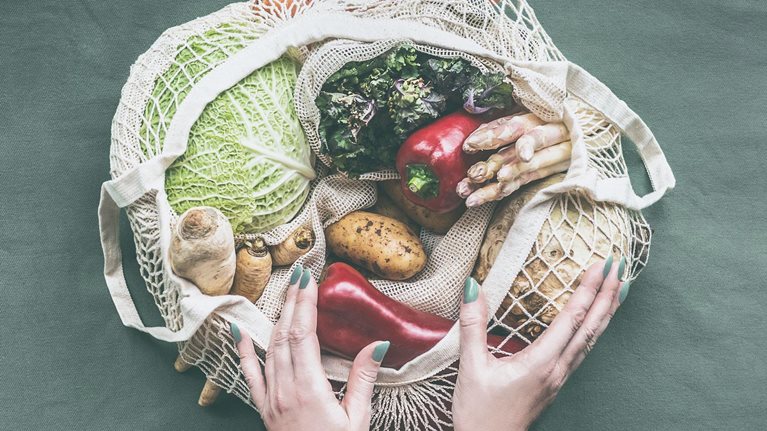For many European grocery retailers, 2020 was the year that saw emerging consumer trends suddenly go into overdrive. With restaurants, offices, and schools largely closed in most countries during the first wave of the pandemic, consumers rushed to stock up on groceries, both in stores and online. In France, Germany, Italy, Spain, and the United Kingdom, grocery sales during the onset of the first lockdown in March 2020 increased by about 20 percent, on average, over the same period in 2019. Retailers faced difficulties to fulfill the sudden peaks in demand as fear of stock-outs led to hoarding, which, in turn, created further stock-outs—all leading to further stress for consumers.
It wasn’t until after this major disruption that both consumers and grocers realized the pandemic was going to last for months, and adapted their business models and shopping behavior accordingly. Two fundamental drivers, however, continue to shape the way consumers shop for groceries.
Government restrictions. More safety regulations led to an increase in demand for both online and (especially in cases of harder lockdowns) local shopping, while the closure of restaurants and cafés combined with a rise in remote working led consumers to shift their food spending from foodservice to grocery retail.
Consumer focus on health. With growing insight into infection risks and prevention measures, consumers increasingly preferred to avoid crowded places—such as busy stores or public transportation—in an effort to protect themselves and others.
Together, both government restrictions and a focus on health led to massive changes in mobility patterns. European consumers reduced their shopping frequencies by around 5 percent on average, while increasing basket sizes by approximately 16 percent.1 Overall, mobility of consumers has decreased and mobility patterns have been redistributed amongst different destinations. For instance, on average, the number of visitors to workplaces had decreased by 25 percent, while visits to residential areas had increased by 8 percent in 2020.2 The online channel, for example, grew by about 55 percent on average across Europe, while hypermarkets only saw a growth of about 3 percent.
While these trends generally hold true across Europe, consumer behavior differed in individual regions depending on local circumstances. In Italy, which restricted people to shopping only within close proximity to their homes, sales at local neighborhood stores soared. By contrast, in Sweden—which implemented the fewest restrictions in Europe and thus saw much less change to mobility patterns than other countries—consumers consolidated their shopping and tended to do it in large hypermarkets on the outskirts of town, which they perceived to be less busy and thus safer. In part due to this perception, shopping frequency of Swedish consumers increased slightly, contrary to the predominant trend in the rest of Europe. As a consequence, Swedish hypermarkets grew their revenues at a pace more than twice as high as the European average of 3.3 percent.3
Five major forces shaping the market in 2020
Five major forces stood out across European grocery retail markets, reshaping consumption patterns and everyday operations of grocers.
1) Grocery spending at an all-time high
Grocery was one of just a few retail subsectors that grew consistently in 2020: volume increased by around 8 percent and value by slightly more than 10 percent, in particular in categories related to the trend of spending more time at home.4 With remote working, school closures, and restrictions on restaurant dining, grocery retail’s share of volume rose. Other product categories that benefited from this overall context were cleaning and household products, whereas “social” categories related to going out or going to work, such as personal care, rather suffered.
We expect that the unprecedented overall growth rate of 2020 will be hard to sustain. Some new habits, such as working from home or cooking more often, may stick going forward even as the fundamental drivers, including the need to avoid infection transmission or the restrictions on restaurants and bars, will at least partly disappear. Grocery retail seems to be positioned well, even for the post-COVID-19 time, with consumer spend intentions clearly favoring grocers (positive intent) over take-out or seated restaurants (both with negative intent). Nevertheless, a clear prediction is hard to make given the very different scenarios on how quickly the health crisis will be resolved, and how significant the economic crisis will turn out to be. It does however seem improbable that grocery spendings will stay at their very unusual high levels: once the pandemic eventually ends and economic recovery sets in, people are highly likely to return to the “next normal”—where grocery retail will once again need to rebalance its role within the broader ecosystem with restaurants and other options.
2) Further polarized demand with consumers trading up or down
The economic effects of the pandemic have led to a polarization of consumers—some trade up to buy more expensive products, while others trade down to cheaper versions. Uptrading is very likely due to higher disposable incomes from lower spending in other categories, coupled with the increased importance of cooking at home and healthy eating. Overall, around 30 percent of consumers say that they are planning to spend more money on sustainable and healthy products in 2021 compared with last year. Meanwhile, consumers who were hit directly by the economic effects of the crisis have clearly tended to shift toward value. Indeed, 19 percent of consumers say that they have downtraded over the past year. Polarization of customer segments thus has further increased in 2020.
Would you like to learn more about our Retail Practice?
While all countries experience both uptrading and downtrading, the extent varies across countries—with some displaying stronger signs of trading up (for example, Germany, the Netherlands, and the United Kingdom), while others see a heavier trend toward trading down (for example, France, Portugal, and Sweden). Both uptrading and downtrading being present within countries often leads to overall averages that tend to hide the order of magnitude of both. As would be expected, countries experiencing a higher downtrading typically also saw an increase in the purchase of private-label products.
Even with society likely to return to a new normal step by step, this polarization in buying behavior is likely to linger, since it is the acceleration of a trend that we have seen for years. In particular, we expect to see both downtrading and uptrading in 2021 as reactions to the ongoing economic crisis and the limited availability of other food options.
3) Continued online-grocery sales growth
The online channel has experienced unprecedented growth during the COVID-19 pandemic, propelled by consumers looking for safe shopping alternatives. In Europe overall, the online grocery channel experienced a growth of around 55 percent over the past year, compared with an average gain closer to 10 percent in 2019. We observed the highest online growth rates—all above 60 percent—in Sweden, the United Kingdom, Spain, and Italy. In comparison, average growth rates in offline channels were significantly lower: 3 to 12 percent in the main offline channels—such as hypermarkets, supermarkets, and discounters—and around 7 percent in the others. This growth corresponds to a shift in market share of approximately 1.5 percentage points to the online channel, making it the biggest winner in both growth as well as absolute market share gain. Furthermore, online channels contributed to about 20 percent of total grocery revenue growth in 2020, despite having only about 4 percent of market share in 2019.5
Broadly speaking, online won across all countries. In countries with an already high online-grocery penetration, players which were able to pivot quickly and address customer preferences went on to capture significant market share. UK grocery retailers for example saw their online share expand from 7.6 percent in 2019 to 11.2 percent in 2020 (reaching 13 percent market share at the highest point), corresponding to a revenue growth of 67 percent.6 In markets that had proven less savvy on online shopping, many incumbents benefited from their recently established online presence. For instance, in Sweden the online channel grew by around 100 percent in 2020, compared with less than 10 percent in 2019—the strongest growth rate seen across Europe.
Though impressive, online growth rates are likely to even be under-representing the market potential given that at least some players were unable to keep up with the exploding demand. This “growth pain” likely left customers with a frustrating experience and may have been one driver of demand curves somewhat flattening again after the first peak. Full-year growth, albeit impressive, is likely to still be significantly below peak numbers for many countries for the same reason.
Consumer survey data are projecting that users of online grocery retail channels are likely to largely continue their use in 2021—the spending intent after COVID-19 for online grocery is expected to drop by just 10 percent. Having learned to appreciate the convenience of shopping online, consumers will at least partly stick to this habit even after the pandemic abates—increasing the need for retailers to finally seek a path to profitability for their online offering.
4) A shock to customer loyalty
The pandemic has delivered a massive shock to customer loyalty across every dimension—providing a unique opportunity for grocers. Indeed, more than 60 percent of consumers have changed their shopping behaviors. Most importantly, 31 percent of consumers say they changed the store or banner they shop in (Exhibit 1), the key reasons being better value (especially prices) and convenience—particularly easy access or delivery options (Exhibit 2). Consequently, grocery retailers have a historic opportunity to attract new customers by better adapting to their changing needs and providing them with a superior value proposition. And, since more than 70 percent of customers say that they intend to stick to their new behaviors, there is a real chance to retain them in the longer term.


5) An acceleration of consciousness about health and environment
Over the course of the pandemic, consumers shifted their spending significantly toward products that are healthy, environmentally friendly, and local. Around 60 percent of them—across many ages, genders, or other demographics—say that they are willing to pay more for sustainable alternatives. Thirty percent of European survey respondents reported that they plan to focus on healthy eating and nutrition more in 2021 compared with 2020.
Similarly, despite the pandemic, the number of “eco-actives”—consumers who are most aware of sustainability issues and most active in reducing their environmental footprint— has continued to increase across Europe. France, Germany, and Spain, for example, saw this category rise six to ten percentage points in 2020.
The past year has also shown that consumers look not only for healthy food but also for healthy and hygienic packaging (Exhibit 3).

Buying sustainable and eco-friendly products also increased in net spending intent by 8 percent or more.
The winners of 2020
Grocery retailers that were able to capitalize on the five market forces outlined above—be it through a strong online presence, higher convenience due to proximity, or less crowded stores—emerged as the winners in 2020.
As a channel, online was the clear winner: in 2020, its market share across Europe increased, on average, by 1.5 percentage points from a 2019 base of 3.7 percent.7 While the established French and British online grocers led in absolute revenue growth (some of them adding more than €1 billion in online sales), players from other countries with a smaller base grew fast on a relative scale (for instance, ICA, REWE and Picnic all grew their online businesses by 80 percent or more).8
By store format across European countries, discounters gained market share (+0.4 percentage points), while supermarkets remained neutral and hypermarkets (–1.2 percentage points) and other channels (–0.7 percentage points) lost out.9 For discounters, the picture is divided geographically: while the market shares of players in Western Europe stagnated, their Eastern European peers continued on a steep growth trajectory (with an increase of one to three percentage points in market shares, depending on the country) fueled by new store openings. On the negative side, hypermarkets and traditional channels continued to lose market share, a trend that was well established before 2020 and accelerated during the pandemic. It is worth noting that supermarkets—and discounters—benefited from the behavioral changes driven by the pandemic and experienced stronger-than-average growth compared to other offline channels. They were also able to sustain their market shares more than hypermarkets and traditional channels by harnessing their convenience advantage (a one-stop shop often in close proximity to the consumer) as well as addressing consumer preferences for healthy and sustainable products with corresponding assortment offerings.
Key takeaways of 2020
Overall, 2020 was a highly challenging year for grocery retailers. Besides many operational issues to solve, among the hardest issues to tackle was undoubtedly the task of taking care of fears and anxiety among frontline employees—who mostly kept working with direct customer contact even during the lockdown periods. At the same time, the markedly higher demand made it a rewarding year for most players. Retailers with a strong online offering (and enough capacity) and those with stores in close proximity to consumers managed to grow their market shares.
For 2021 we expect that while some of the pandemic effects on grocery shopping will start to fade, the major developments of 2020 are likely to stick: consumer polarization will continue; a significant portion of the higher online penetration will be permanent; customers that were changing stores, channels, or brands may stick with their new choices; and healthy and sustainable food will continue to grow. Compared with 2020, grocery spending is expected to decrease slightly in 2021, and continue declining during 2022, depending on the speed of returning to a new normal. However, it will remain at a higher level compared with 2019 thanks to the still high shares of home consumption.
The main lesson for grocers (and other retailers) is the need to be able to act with agility in unprecedented times. The ability to adapt offerings to fast-changing consumer behaviors—by scaling capacity or flexibly adjusting services for example—proved to be crucial in 2020. The outlook for 2021 remains uncertain and the need for a continued ability to adjust is definitely here to stay.


